Mar 04, 2014
A Revisit: Outstanding Estates - Santa Rita and Tarapacá
with Matetic, Indomita and DeMartino
My first visit to Chile, in 2008, was undoubtedly an eye-opener.
My early days of drinking the wines from this South American country (circa 1990s) were less than memorable, the wines were still incredibly rustic and simple but they were gaining ground due to appealing price points.
Of course things have changed, dramatically.
While the value remains, quality is equally oustanding.
My visit in 2008 was more of an introduction into regions and varieties.
Chile is a long country, 4,270 kilometers by a mere 177 kilometers wide.
We traveled great distances (first north, then south) by van and found ourselves at a new hotel each night. Our stops included: Aconcagua; Maipo (the main traditional and most central wine growing region, close to Santiago); Rapel Valley; Curico Valley; Maule and Curicó.
2008 was a tour of culture as much as it was of wine.
We danced the Cueca (Chile's national dance) on a hilltop in Maipo with women in 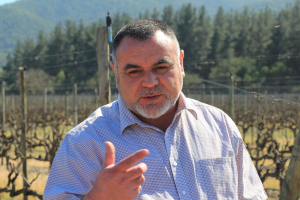 traditional wide skirted dresses and men dressed as huasos (cowboys) in brimmed straw hats and black bolero suits. We were treated to seafood, parallaida (barbecue) avocados, hearts of palms, sopapillas (small fried disc-shaped bread) and empanadas. traditional wide skirted dresses and men dressed as huasos (cowboys) in brimmed straw hats and black bolero suits. We were treated to seafood, parallaida (barbecue) avocados, hearts of palms, sopapillas (small fried disc-shaped bread) and empanadas.
We rode horses and bikes through vineyards, talked to llamas, chased geese and drank Pisco Sours whenever we weren't tasting an amazing assortment of wines. I had my first encounter with biodynamic practices and vineyards at Cono Sur and Emiliana (since then I've visited many around the world) and dripped sweat over parched earth during a sudden spring heat wave.
2008 was my first wine trip to the southern hemisphere and I was entranced.
(right above: Santa Rita vineyard manager Julio Cornejo explaining the massive damage
early frosts did to his vineyard in Casablanca; below: Santa Rita's Casablanca vineyard)
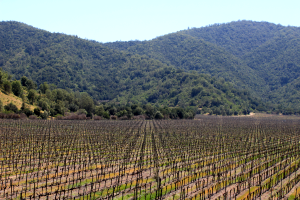
At the time we were introduced to Chile's diversity of wine regions more in a north and south manner. There was a peppering of emphasis on east to west from some who were broadening their vineyard horizons. Some were planting in exciting newer regions; westward, closer to the ocean or east into the piedmonts of the Andres while maintaining their central valley vineyards.
The coastal regions - cooler sites with Pacific breezes and in some cases fog - were becoming increasingly desirable for varieties such as Sauvignon Blanc, Chardonnay, Pinot Noir and Syrah.
(Right and below: Santa Rita's Leyda vineyard, foggy and much cooler)
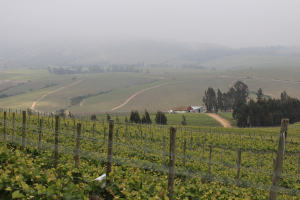 During my 2013 trip, east to west was boldly underlined. During my 2013 trip, east to west was boldly underlined.
(See map: top right)
Chile's theme had altered and the focus was almost entirely on the diversity of vineyard sites. Those farthest east, along the Andes Mountain Range, boast higher altitudes, which give way to larger diurnal swings (larger temperature fluctuations between day to night). Worldwide, these higher altitude vineyards show thicker skins in grapes, smaller and more concentrated berries; intensity with acidity. The more fertile central valleys have warmth to ripen big reds and still bear the weight of most vineyards and overall agriculture.
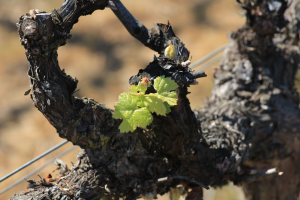 The most westerly and much cooler coastal vineyards (certainly the most talked about) were best experienced. The most westerly and much cooler coastal vineyards (certainly the most talked about) were best experienced.
A day with the team at Santa Rita had me wandering through a vineyard in Casablanca in shorts, sniffing acacia blossoms from the surrounding trees. A 20-minute drive to Leyda (in San Antonio Valley, only handful of kilometers from the Pacific) found temperatures 15 degrees cooler (on that day) and had me shivering in the mid-day fog and wind.
I may not have believed it, had I'd not experienced it myself.
(Right above: Bud break in Santa Rita's Casablanca vineyard, late after devastating frosts; below, vine in the much warmer Apalta, in Colchagua in the Carmen vineyard is more advanced)
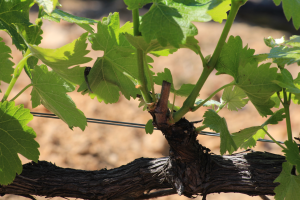 For a complete map, including the Costal (Costa) Central (Entre Cordillera) and Andes regions link here For a complete map, including the Costal (Costa) Central (Entre Cordillera) and Andes regions link here
Santa Rita
In October of 2013 I found myself back in Chile, this time with a lot more focus on terroir, emerging regions and exploding varieties. There was a little less emphasis on culture but more on soil and various terroirs. It was much cooler, the vines just starting to come
into bloom and the results of devastating early spring frosts were
evident, especially in Casablanca. 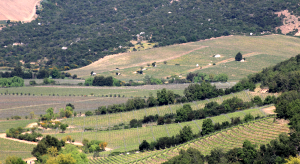
My tour was a deliberate visit to Viña Santa Rita, where I was a guest with a dozen or so other journalists from around the world. We were there to witness the unveiling of Santa Rita's new ultra-premium wine, Bougainville. The inky 2010 Petite Sirah comes from pergola-trained vines on the estate vineyard in Alto Jahuel (45 kilometers south of Santiago) where Santa Rita sits.
This time I stayed on the estate, at Casa Real, the private hotel of Santa Rita.
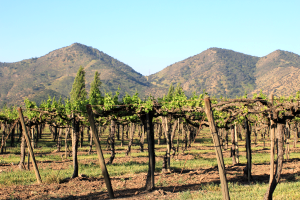 I unpacked my bags for a few days and made good use of my runners during my early morning routine. Over three days I visited Santa Rita's vineyards in Casablanca; the cool and very "cool" Leyda (where Pinot Noir is making a name); the Santa Rita pioneered Pumanque (a stunning 1200 hectares closer to the ocean) and Apalta (owned by sister winery Carmen) - both in Colchagua. I unpacked my bags for a few days and made good use of my runners during my early morning routine. Over three days I visited Santa Rita's vineyards in Casablanca; the cool and very "cool" Leyda (where Pinot Noir is making a name); the Santa Rita pioneered Pumanque (a stunning 1200 hectares closer to the ocean) and Apalta (owned by sister winery Carmen) - both in Colchagua.
(Photos. Above right: Steeply sloped vineyards in Apalta; right: Pergola trained Petite Sirah vines in Santa Rita's Alto Jahuel estate; below: the Cathedral on the Sanata Rita walled estate)
►See my wine reviews of Santa Rita wines on Winescores.ca
►I wrote about this visit, the wine and Santa Rita in the April 2014 issue of Vines magazine.
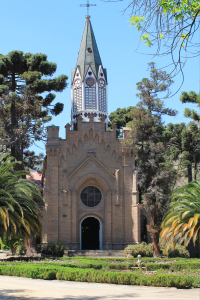 Tarapacá Tarapacá
Following an incredibly informative visit with Santa Rita I had the pleasure of returning to another impressive and sprawling 135-year-old estate - Tarapacá
Once you enter the estate in Isla de Maipo and pass the first guard house (they must ensure you're expected) there is a long, meandering drive until you reach the main guardhouse and finally the winery, the fantastic historic manor house, plush grounds, air strip and pool. The estate is 2600 hectares so the drive is long but stunning. In this somewhat u-shaped valley are 600 hectares of planted vines.
Viña Tarapacá was purchased right around the time of my initial visit in 2008 by Groupo San Pedro (VSPT, who also owns Leyda, Santa Helena, Viña Mar, Casa Rivas as well as wineries in Argentina).
Tarapacá wines are Maipo Valley wines. While many larger
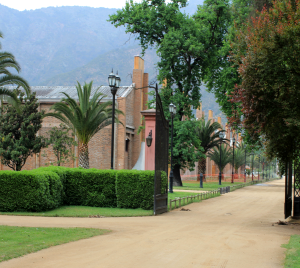 producers have pressed out to other regions, cooler or warmer, producers have pressed out to other regions, cooler or warmer,
in order to diversify their wine portfolios, Tarapacá has stayed true to
Chile's most traditional, central fine-winemaking region.
Winemaker Edward Flaherty has a lot to do with that continued focus.
During my last visit, Flaherty had only been with Tarapacá for a couple of years. The past year (2013) year he celebrated 20 years in Chile and eight years at Tarapacá.
Tarapacá has an impressive array of wines under a number of labels and ranges. They produce two lovely sparkling wines as well as their entry level Tarapacá Varietal, Tarapacá Reserva, Tarapacá Terroir, Tarapacá+Plus, Tarapacá Gran Reserva, 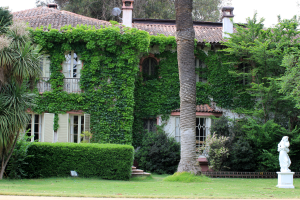 Tarapacá Gran Reserva Etiqueta Negra, Zavala and the iconic, limited Tara-Pakay Tarapacá Gran Reserva Etiqueta Negra, Zavala and the iconic, limited Tara-Pakay
(Above right: The entrance to Tarapaca esate's manor house looking back toward the winery; right the historic manor house; below: looking out over the vast expanse of the Tarapaca estate in Isla de Maipo)
You may also be familiar with the Leon de Tarapacá wines available locally. These wines offer incredible value at under $13.
Leon de Tarapacá Sauvignon Blanc 2012 - sweet tropical fruits such as guava, grass clippings and floral notes in a very quaffable
and fresh palate. ($12.99)
Leon de Tarapacá Leon de Tarapacá Malbec~Syrah 2012 -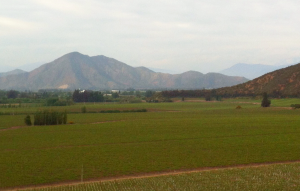
offers jammy ripe berry flavours, plush raspberry, vanilla, sweet
spices and tobacco in a supple palate. ($12.99)
Also available:
Tarapacá Gran Reserve Syrah, 2008 from a cooler Maipo site it is a gorgeous style with sweet high-toned berry aromas (bleuberry and raspberry), peppery spices and mocha. The palate is plush and wonderfully fresh. Elegant and lengthy. ($20+ private wine stores)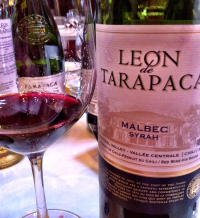
Tarapacá Gran Reserva Sauvignon Blanc, 2010 is a stunning white with a golden tinge and aromas of elderflower, guava, honey, gooseberry and grapefruit above asparagus and snap peas. It has a lovely weight and complexity on the palate with fantastic persistence. ($20+ private wine stores)
Tarapacá Gran Reserva Cabernet Sauvignon, 2011 - Spicy red and black currents, mint and bay leaf aromas lead to a supple palate with generous fruit, which maintains classic Cabernet character. Fine cocoa tannins linger on the finish. ($20.99 BCLDB)
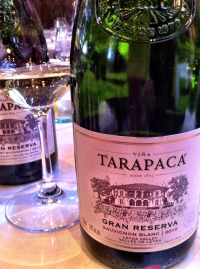
Indomita
If you've ever driven through Casablanca there's no doubt you'll have noticed the big white castle-type building high up on the hillside.
The house is built in a Moroccan/Spanish style and the name means "wild" or "untamed" in reference to the Arabian horses once bred and trained on the site.
Viña Indomita came to fruition in 2000, starting with Casablanca Sauvignon Blanc and Chardonnay, which had been planted in 1998. They sold their first wines in 2001 along with a Merlot from the Rapel Valley.
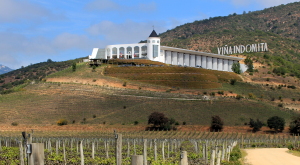 A group of Chilean investors purchased Indomita in 2006 but maintained the same winemaker, Roberto Carranca. A group of Chilean investors purchased Indomita in 2006 but maintained the same winemaker, Roberto Carranca.
Under new ownership, they began to export their wines (now in 40 countries - although not in Canada, yet) with an emphasis on the northern European markets and their love of bag-in-box wines.
The 180 estate hectares in Casablanca contain a combination of Chardonnay, Sauvignon Blanc, Pinot Noir and Merlot with an additional 320 hectares for red varieties, in Maipo.
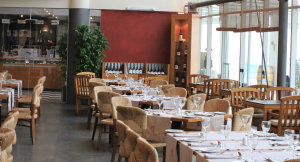 While Indomita does not currnetly sell into the Canadian market, their sister winery (I visited there in 2008) does. While Indomita does not currnetly sell into the Canadian market, their sister winery (I visited there in 2008) does.
During my visit I sat down to taste wines in the visitors center restaurant (right).
It proved to be a popular destination for locals. A young musician wandered around the room serenading the guests without being intrusive. The winery recently brought on a new, well-known Chilean chef, Tomas Olivera, who had left the Hyatt in Santiago to take over
the kitchen and revamp the menu.
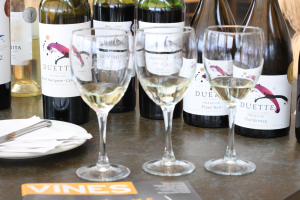 While there, the old menu was still in place, but the plan was to create traditional Chilean fare with international touches. Chef prepared me a fantastic salad of figs and goat cheese followed by mushroom ravioli. While there, the old menu was still in place, but the plan was to create traditional Chilean fare with international touches. Chef prepared me a fantastic salad of figs and goat cheese followed by mushroom ravioli.
Wines
Indomita offers three ranges of wines, the top tier being Zardoz, the second Duette and entry level Gran Reserve.
The Gran Reserve wines offer solid value, the 2012 Sauvignon Blanc is fresh and zesty but 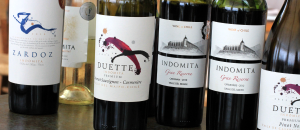 with a creamy weight and buttery character from some new oak contact. The 2012 Camenere (Maipo) offers liberal blueberry, sweet spice and savoury green flavours. with a creamy weight and buttery character from some new oak contact. The 2012 Camenere (Maipo) offers liberal blueberry, sweet spice and savoury green flavours.
The Duette Pinot Noir 2011 is a leaner style; red fruit, tobacco and beet greens with mineral tones while the Indomita Gran Reserve is juicy and fruity with sweet spice. A standout for me was the 2011 Duette Chardonnay, laden with melon and tropical fruits, nuts and lemon curds, it has a rich and creamy texture, loads of tropical fruit and citrus with a long but phenolic finish. Additionally, the harmonious Duette 2010 Cabernet-Carmenere (Maipo) top tier 2011 Zardoz (they began making this wine in 2008) made from 100% Cabernet Sauvignon from Maipo is seductive and supple with oodles of ripe wild berries, vanilla, graphite, pipe tobacco and leather.
Matetic
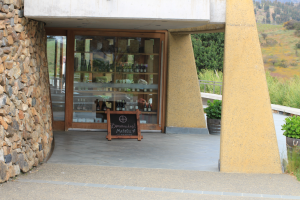
Standing alone, amongst 10,000 hectares in the beautiful Rosario Valley (part of San Antonio) is a stunning building, modern yet at one with its environment.
It is It is known as Matetic (Ma-teh-TEACH).
Surrounding the winery, 170 hectares of planted vines roll and undulate with the topography, hemmed in on all sides by foothills. This is a cool-climate region only 18 kilometers from the Pacific. Sauvignon Blanc, Chardonnay and the less common (in Chile) Riesling and Gewurztraminer are planted here as well as Pinot Noir, Syrah and small amounts of Malbec and Cabernet Franc.
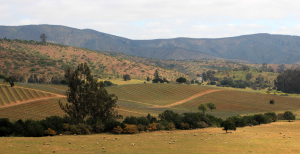 The entire estate is biodynamic and has been since day one. It is also one of the largest biodynamic vineyards in Chile. The entire estate is biodynamic and has been since day one. It is also one of the largest biodynamic vineyards in Chile.
The estate (right) was planted in 1999 with the assistance and consultation of biodynamic pioneer, Allan York (sadly, York passed away in February 2014), known for his work at Benzinger. The winery had their first harvest in 2001, the first wines were in bottle in 2002.
Despite peers thinking they were crazy, Matetic was the first to plant Syrah in a cool-climate region in Chile and unknowing launched one of Chile's most exciting wine trends.
Matetic is one of the most pristine and well designed wineries I've visited, anywhere in the world. The stone walls, built with local alluvial stones, melds perfectly with the environment and assists with natural temperature control. They are, without doubt, in the upper echelon of Chilean wines.
Wines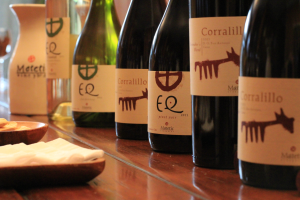
Matetic EQ Coastal Sauvignon Blanc 2012 (DO Casablanca) is a vibrant and juicy offering of guava, nettle, gooseberry and citrus with great concentration and unique textural component. An elegant wine, with mouthwatering but not aggressive acidity.
The 2011 EQ Chardonnay (DO San Antionio) is perfectly balanced. It has a buttery and leesy nose and creamy palate with mineral texture and flavours of nutty brioche, pastries, citrus and spice.
The 2011 EQ Pinot Noir (DO Casablanca) opens up with generous cherry and raspberry then offers Szechuan peppercorns, violets and sweet spice. The palate is silky and generous with raspberry tea and high-toned fruit followed with impressive length.
Finally, the EQ Syrah 2010 (DO San Antonio) has a mineral and savoury nose with saddle leather, wild blackberries, smoked herbs and pepper. A surprisingly powerful wine with fantastic concentration and flavours of mint, bittersweet cocoa and peppery spices.
*EQ = balance, equilibrium.
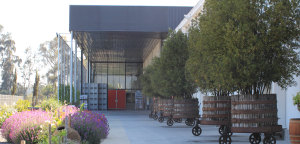 DeMartino DeMartino
DeMartino's goal is to stand out and make their own mark in the Chilean wine industry.
I applaud this family, not only for their organic vineyard practices and (somewhat controversial) natural winemaking but for sourcing grapes from long forgotten vineyards outside of common regions
to put a stamp of tradition on
their products while introducing wine drinkers to some of Chile's history.
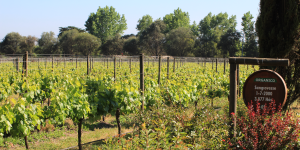 The winery was established in 1934 by an Italian immigrant who settled here, in its current location of Isla de Maipo. The second, third and fourth generations are currently involved in this family winery. DeMartino has 710 hectares in total with the smallest portion around the winery itself. All of the DeMartino vineyards are organic (certified in 2006) and they were the first carbon neutral winery in Chile. After the massive 2010 earthquake, which shook the country and destroyed many tanks, wine and portions of wineries (among other destructions), the family built a new section of winery - completed in 2011 (top right). The winery was established in 1934 by an Italian immigrant who settled here, in its current location of Isla de Maipo. The second, third and fourth generations are currently involved in this family winery. DeMartino has 710 hectares in total with the smallest portion around the winery itself. All of the DeMartino vineyards are organic (certified in 2006) and they were the first carbon neutral winery in Chile. After the massive 2010 earthquake, which shook the country and destroyed many tanks, wine and portions of wineries (among other destructions), the family built a new section of winery - completed in 2011 (top right).
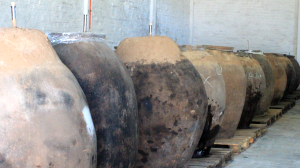 In addition to their organic wines, DeMartino produces natural wines, which are made without intervention or chemicals, from organic grapes. In their first foray into natural wine, it was made from 30+ year-old Cinsault vines DeMartino purchased from the southern region of Itata. In addition to their organic wines, DeMartino produces natural wines, which are made without intervention or chemicals, from organic grapes. In their first foray into natural wine, it was made from 30+ year-old Cinsault vines DeMartino purchased from the southern region of Itata.
DeMartino's natural wine.
The process was described to me as such: The grapes and stems are separated and the grapes are put into massive clay pots (right). They are left for two months (the pot openings are covered in plastic) while carbonic maceration takes place - a natural fermentation. The product inside is removed and liquids separated from solids (grapes seeds and skins). The liquid is then moved to another pot, topped in more plastic then a clay topper while the wine goes through its second fermentation. It remains in these sealed vessels for five more months (for a total of seven months).
Initially DeMartino started with 14 clay pots and in 2011 they produced 4000 bottles from those pots, which sold out in two months.
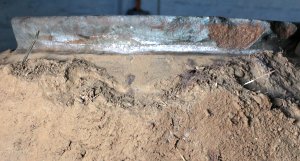 The winery now has 150 clay pots and are also making wine from Carignan and Muscat. Nothing is added to the wines, including sulpher. The winery now has 150 clay pots and are also making wine from Carignan and Muscat. Nothing is added to the wines, including sulpher.
Sulpher exists in nature and it's impossible to have a wine with no sulpher, but in the case of natural wines there is a very low ratio of naturally occurring sulpher.
Sulpher Dioxide (SO2) is a preservative and also acts as an antioxidant, among other things. Natural wine makers believe that while it kills bad bacteria it also kills the good stuff, making wines with less sense of place. In essence, stealing the terroir from the wine.
DeMartino's natural wines are currently exported to Brazil, USA and Canada.
Wines
 Gallardia del Itata Muscat 2012 is made in stainless steel from gobelet (bush) vines 30+ years old grown in a vineyard 26 kilometers from the Pacific, in Itata. It is a lovely white flowing with the fragrance of apricots, honey, pretty spring blossoms, white raisins, ginger and lime zest. It is tangy, mostly dry and very crisp with a slightly spritzy character and exuberance. It reminded me a lot of the Argentine Torrontes. Gallardia del Itata Muscat 2012 is made in stainless steel from gobelet (bush) vines 30+ years old grown in a vineyard 26 kilometers from the Pacific, in Itata. It is a lovely white flowing with the fragrance of apricots, honey, pretty spring blossoms, white raisins, ginger and lime zest. It is tangy, mostly dry and very crisp with a slightly spritzy character and exuberance. It reminded me a lot of the Argentine Torrontes.
DeMartino Viejas Tinajas "Edicion Especial' 2012 is a blend of 39% Cinsault with 61% Carignan from 30+ year old dry farmed vines in Itata. This is a natural wine and has a very rustic and earthy quality. Brambleberries, dusty earth, currents lead the nose and flavours of mineral, clay, coffee and dried herbs on the palate.
DeMartino Alto de Piedras 2011 is a single, organic vineyard Carmenere from their Isla de Maipo estate. The nose emits peppery spices, roasted red bell peppers, current and purple fruits above an earthy core. It has a supple texture and savoury flavours with a good dose of bay leaf.
 This is a food wine with fine tannins. This is a food wine with fine tannins.
DeMartino Limavida 2011 is made from a single vineyard from old bush vines planted in 1945 in a coastal mountain site in Maule Valley. It is a field blend of Malbec, Carmenere, Carignan and Tannat. Spicy red fruits - cherry, red plum and currents, roasted bell peppers, coffee and leather notes lead to a plate of purple and red berries, mineral and dry earth. It's a leaner style of red with wonderful acidity, which will compliment not dominate, dinner.
►More DeMartino wine reviews here
~Daenna Van Mulligen
|


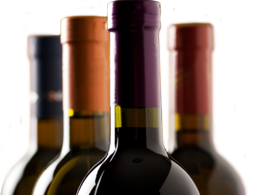


 traditional wide skirted dresses and men dressed as huasos (cowboys) in brimmed straw hats and black bolero suits. We were treated to seafood, parallaida (barbecue) avocados, hearts of palms, sopapillas (small fried disc-shaped bread) and empanadas.
traditional wide skirted dresses and men dressed as huasos (cowboys) in brimmed straw hats and black bolero suits. We were treated to seafood, parallaida (barbecue) avocados, hearts of palms, sopapillas (small fried disc-shaped bread) and empanadas.
 During my 2013 trip, east to west was boldly underlined.
During my 2013 trip, east to west was boldly underlined. The most westerly and much cooler coastal vineyards (certainly the most talked about) were best experienced.
The most westerly and much cooler coastal vineyards (certainly the most talked about) were best experienced. For a complete map, including the Costal (Costa) Central (Entre Cordillera) and Andes regions link
For a complete map, including the Costal (Costa) Central (Entre Cordillera) and Andes regions link 
 I unpacked my bags for a few days and made good use of my runners during my early morning routine. Over three days I visited Santa Rita's vineyards in Casablanca; the cool and very "cool" Leyda (where Pinot Noir is making a name); the Santa Rita pioneered Pumanque (a stunning 1200 hectares closer to the ocean) and Apalta (owned by sister winery Carmen) - both in Colchagua.
I unpacked my bags for a few days and made good use of my runners during my early morning routine. Over three days I visited Santa Rita's vineyards in Casablanca; the cool and very "cool" Leyda (where Pinot Noir is making a name); the Santa Rita pioneered Pumanque (a stunning 1200 hectares closer to the ocean) and Apalta (owned by sister winery Carmen) - both in Colchagua.  Tarapacá
Tarapacá producers have pressed out to other regions, cooler or warmer,
producers have pressed out to other regions, cooler or warmer, Tarapacá
Tarapacá 


 A group of Chilean investors purchased Indomita in 2006 but maintained the same winemaker, Roberto Carranca.
A group of Chilean investors purchased Indomita in 2006 but maintained the same winemaker, Roberto Carranca. While Indomita does not currnetly sell into the Canadian market, their sister winery (I visited there in 2008) does.
While Indomita does not currnetly sell into the Canadian market, their sister winery (I visited there in 2008) does. While there, the old menu was still in place, but the plan was to create traditional Chilean fare with international touches. Chef prepared me a fantastic salad of figs and goat cheese followed by mushroom ravioli.
While there, the old menu was still in place, but the plan was to create traditional Chilean fare with international touches. Chef prepared me a fantastic salad of figs and goat cheese followed by mushroom ravioli. with a creamy weight and buttery character from some new oak contact. The 2012 Camenere (Maipo) offers liberal blueberry, sweet spice and savoury green flavours.
with a creamy weight and buttery character from some new oak contact. The 2012 Camenere (Maipo) offers liberal blueberry, sweet spice and savoury green flavours.
 The entire estate is biodynamic and has been since day one. It is also one of the largest biodynamic vineyards in Chile.
The entire estate is biodynamic and has been since day one. It is also one of the largest biodynamic vineyards in Chile.
 DeMartino
DeMartino The winery was established in 1934 by an Italian immigrant who settled here, in its current location of Isla de Maipo. The second, third and fourth generations are currently involved in this family winery.
The winery was established in 1934 by an Italian immigrant who settled here, in its current location of Isla de Maipo. The second, third and fourth generations are currently involved in this family winery.  In addition to their organic wines, DeMartino produces natural wines, which are made without intervention or chemicals, from organic grapes. In their first foray into natural wine, it was made from 30+ year-old Cinsault vines DeMartino purchased from the southern region of Itata.
In addition to their organic wines, DeMartino produces natural wines, which are made without intervention or chemicals, from organic grapes. In their first foray into natural wine, it was made from 30+ year-old Cinsault vines DeMartino purchased from the southern region of Itata. The winery now has 150 clay pots and are also making wine from Carignan and Muscat. Nothing is added to the wines, including sulpher.
The winery now has 150 clay pots and are also making wine from Carignan and Muscat. Nothing is added to the wines, including sulpher. Gallardia del Itata Muscat 2012 is made in stainless steel from gobelet (bush) vines 30+ years old grown in a vineyard 26 kilometers from the Pacific, in Itata. It is a lovely white flowing with the fragrance of apricots, honey, pretty spring blossoms, white raisins, ginger and lime zest. It is tangy, mostly dry and very crisp with a slightly spritzy character and exuberance. It reminded me a lot of the Argentine Torrontes.
Gallardia del Itata Muscat 2012 is made in stainless steel from gobelet (bush) vines 30+ years old grown in a vineyard 26 kilometers from the Pacific, in Itata. It is a lovely white flowing with the fragrance of apricots, honey, pretty spring blossoms, white raisins, ginger and lime zest. It is tangy, mostly dry and very crisp with a slightly spritzy character and exuberance. It reminded me a lot of the Argentine Torrontes. This is a food wine with fine tannins.
This is a food wine with fine tannins.